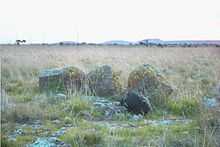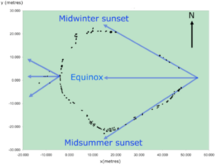Wurdi Youang

Wurdi Youang is an Aboriginal stone arrangement located at Mount Rothwell, near Little River, Victoria. The registered traditional owners of the site are the Wathaurung Aboriginal Corporation.
The arrangement takes the form of an irregular egg-shape or ovoid about 50 m in diameter with its major axis aligning on due East-West.[1][2] It is composed of about 100 basalt stones, ranging from small rocks about 20 cm in diameter to standing stones about 1m high—some of which appear to be supported with ‘trigger stones’—with an estimated total mass of about 23 tonnes.[3] There are three prominent waist-high stones, at its western end, which is the highest point of the ring.[4] The purpose, use, and age of the arrangement are not known.[5] The purpose of the site may be ceremonial in nature as with many other stone arrangements in southeastern Australia.[6]
Astronomical Hypothesis
A series of stones, located to the west of the arrangement's western apex, are claimed to mark the positions of the setting Sun at the equinoxes and solstices.[7] A survey study shows that these alignments are accurate to within a few degrees. Additionally, the straight sides of the arrangement, which diverge from its eastern apex, also indicate the setting position of the sun at the solstices to within a few degrees and at the equinoxes the sun sets over the three prominent stones at the apex.[8][9]

References
- ↑ Norris, R.P.; Norris, P.M.; Hamacher, D.W.; Abrahams, R. (2013). "Wurdi Youang: an Australian Aboriginal stone arrangement with possible solar indications". Rock Art Research 30 (1): 55–65.
- ↑ Wurdi Youang. Australian Indigenous Astronomy Blog, University of New South Wales, Sydney, Australia.
- ↑ Ray Norris et al 2008, ICOMOS–IAU Thematic Study on Astronomical Heritage
- ↑ 'Rocky ways to secrets of skies' Chee Chee Leung The Age August 2, 2008.
- ↑ Hamacher, D.W. & Norris, R.P. (2011). "Bridging the Gap" through Australian Cultural Astronomy. In 'Archaeoastronomy & Ethnoastronomy: building bridges between cultures', Proceedings of IAU Symposium No. 278 held in Lima, Peru from 5–14 January 2011, edited by Clive Ruggles. Cambridge University Press, pp. 282-290.
- ↑ Lane, L. and Fullagar, R. (1980) Previously unrecorded Aboriginal stone alignments in Victoria. Records of the Victoria Archaeological Survey, No. 10, pp. 134-151
- ↑ Morieson, J. (2008). “The case study of the Boorong”, in Jonas Vaiškunas (ed.), Astronomy and Cosmology in Folk Traditions and Cultural Heritage, pp. 258–262. Klaipeda: Klaipeda University Press (Archaeologia Baltica 10).
- ↑ Norris, R.P.; Norris, P.M.; Hamacher, D.W.; Abrahams, R. (2013). "Wurdi Youang: an Australian Aboriginal stone arrangement with possible solar indications". Rock Art Research 30 (1): 55–65.
- ↑ Wurdi Youang rocks could prove Aborigines were first astronomers, Andrew Carswell and Robert Cockburn, Daily Telegraph (Australia), 5 February 2011.
Further reading
- Mountford, C.P. (1927). “Aboriginal stone structures in South Australia”, Transactions and Proceedings of the Royal Society of South Australia 51, 169–172.
- Mountford, C.P. (1976). Nomads of the Australian Desert. Adelaide: Rigby.
| |||||||||||||||||||||||||||||